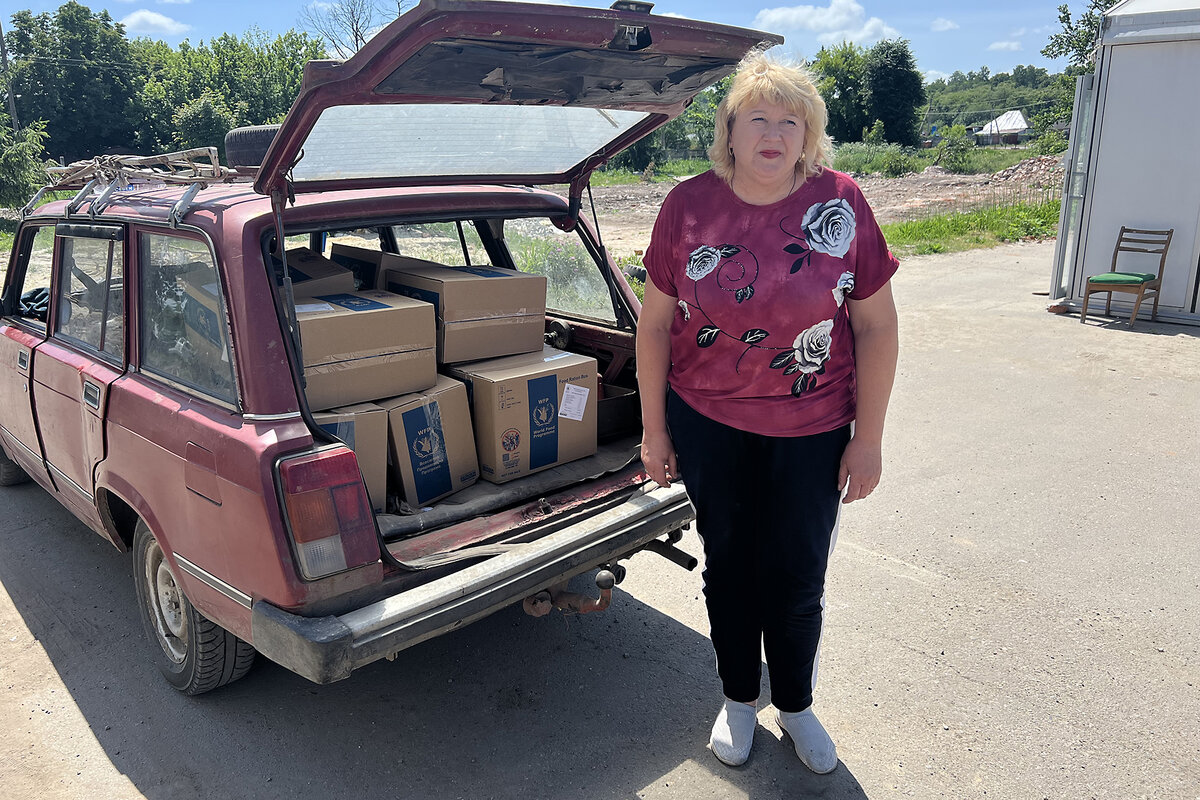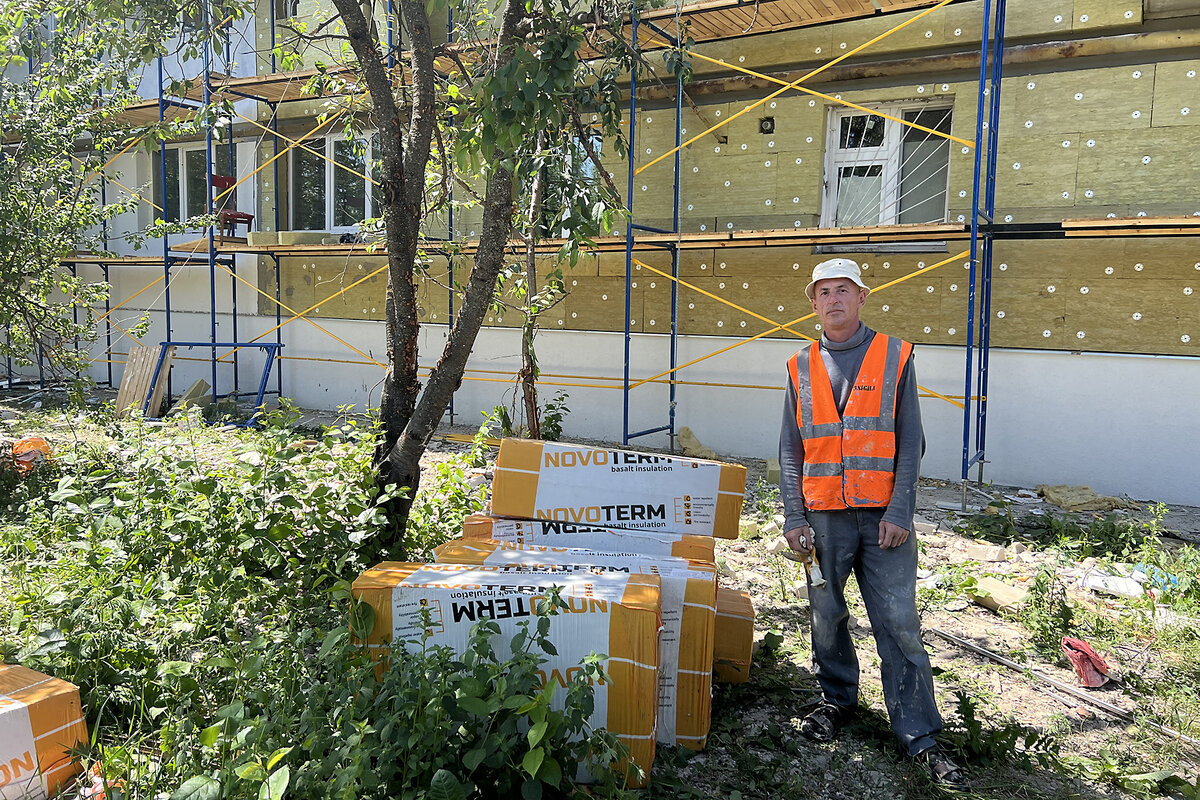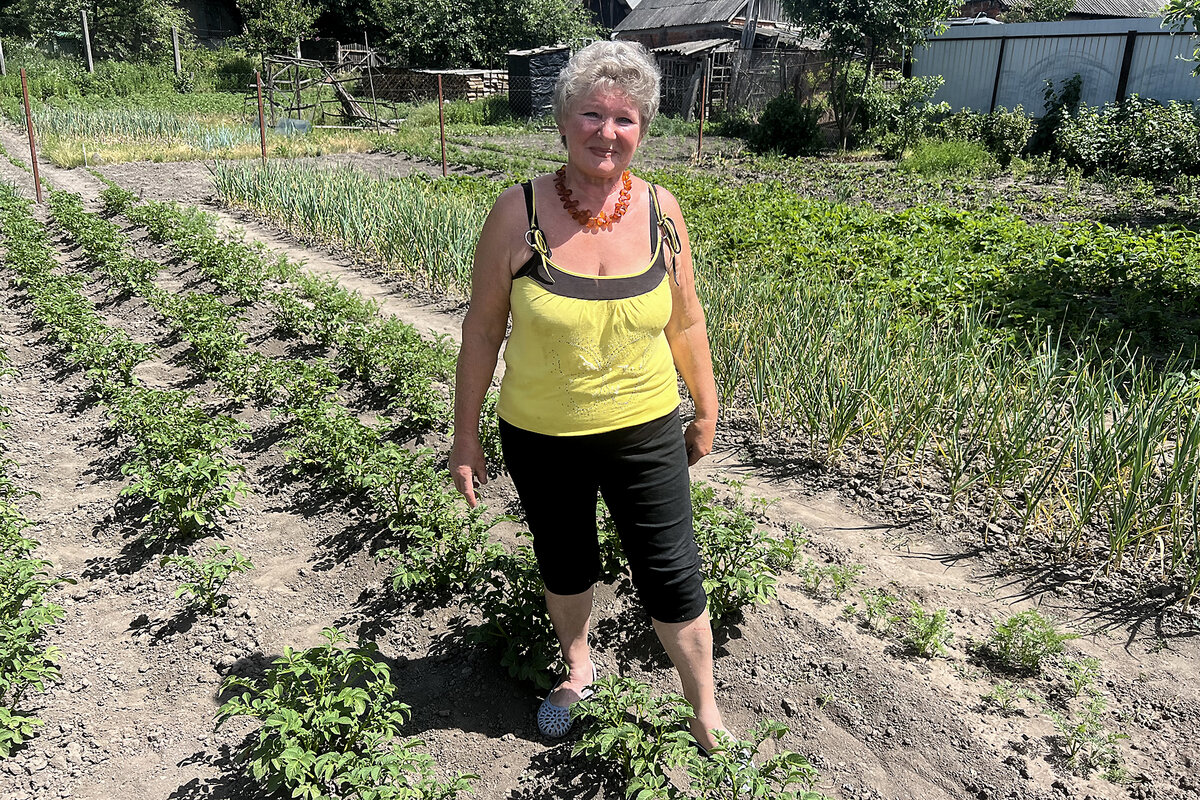Near Ukraine war’s front lines, threatened villages try to build a future
Loading...
| STARYI SALTIV, UKRAINE
Anton Palyey stands proudly before the new three-story school building, its cheery accents of bright paint soon to greet returning students.
It was built to replace the school destroyed by Russian shelling in 2022, when enemy forces occupied this lakeside resort village just 12 miles from the Russian border. Staryi Saltiv was recaptured in a counteroffensive in the fall of 2022.
“If there is no school, no hospital, and no state services, people won’t stay here or consider coming back,” says Mr. Palyey, who has served as Staryi Saltiv’s military-appointed administrator since Ukrainian forces took the village back.
Why We Wrote This
A story focused onFor small villages near the front lines of Russia’s war in eastern Ukraine, the ebb and flow of territorial conquest can make it hard to have confidence in the future. Providing hope is one job of community leaders.
Pointing to the northern horizon, where a plume of dark smoke rises over the town of Vovchansk – destroyed in a surprise Russian cross-border offensive in May – the village administrator describes his job as equal parts services provider and chief reassurer/morale booster.
“With a so-called neighbor like the one we have, capable of doing that at any moment,” he says, nodding toward the smoke, “it’s understandable that people feel so much fear about living here.”
“Our job as a government,” he adds, “is to show the local people that these villages are not abandoned, that they can feel confident that there is a future for this place.”
Hope vs. trepidation
The brand-new school building, and the view of a smoldering town some 30 miles across the river valley, offer a stark juxtaposition of the hope and trepidation that permeate the dozens of villages along the Ukraine war’s front lines.
Many of those villages, like Staryi Saltiv, were once occupied by Russian forces and are now trying to rebuild and recover – despite a nagging worry that the war could engulf them once again.
On the one hand, it’s true that many of Staryi Saltiv’s residential streets are quiet and abandoned, and that its summer population no longer jumps above 20,000, as it did when residents of prewar Kharkiv – Ukraine’s second-largest city – sought the soothing shores of the reservoir formed by the Siverskyi Donets River.
But on the other hand, there is also a deep sense of hope in the future. It’s seen not just in the new school, but also in the ongoing renovation of war-damaged apartment buildings and in the repeated repair of the temporary pontoon bridge that serves as a lifeline to families across the river. Hope is evident, too, in the welcoming committees that greet evacuees from nearby besieged towns like Vovchansk, where fierce fighting continued June 17.
“I’ve decided I’m not afraid anymore. I’m just going to do what I can to help the people of my village who only want to be able to remain in their homes,” says Lidiia Chatchenko, the unofficial mayor (she says it’s a big word for the modest assistance she provides) of the small settlement of Rubizhne outside Staryi Saltiv.
After she lost her house in Rubizhne in the Russian sweep into the area in 2022, Ms. Chatchenko moved to Staryi Saltiv. Now almost every day she loads up her old station wagon with World Food Programme provisions to take to the mostly older residents remaining in her village.
Doing what’s possible
Like others here, Ms. Chatchenko is careful not to sound too naively optimistic about the future. She says Russia is using larger bombs and deadlier tactics in its recent attacks, so she is steeling herself for what could happen if enemy forces were to advance through the area again.
But at the same time, she says she is impelled to do what she can to ease concerns and allow people to live in her village for as long as possible.
“Before the war, our little village was so beautiful. People were proud to keep up their small piece of our lovely area and show it to the world,” she says. “I really hope what I’m doing helps people stay in their homes so we can be that beautiful place again someday.”
That determination to keep Ukraine’s traumatized villages alive can be seen across Staryi Saltiv – from the numerous construction projects to the neat vegetable gardens behind many houses that suggest the promise of a future harvest.
At a construction site, while installing new insulation and basalt siding on an apartment building that took a direct hit in Russia’s assault, Vadym Morozov talks of returning Staryi Saltiv to its glory days as a summertime family retreat.
“Before the war I sometimes brought my family to the resorts here, and most of the time there were so many people you couldn’t find a place on the beach,” says the construction foreman from Sumy, a neighboring region. “People here want to have that again in the future,” he adds, “and I feel like we’re doing our part to make that possible.”
Still, Mr. Morozov is careful to temper his lofty dreams with some realism. He notes, for example, that in all of the multistory residential building repairs he’s done in Staryi Saltiv, upgrading basements to fortified shelters has been a top priority.
“Considering where we are and what could be an uncertain future,” he says, “putting in the shelters is a really important part of our job now.”
Hopes for a tomato harvest
Across the highway in a neighborhood of traditional single-story houses with tidy gardens, Alla Nahorna expresses the same mix of optimism and caution forged by more than two years of a grinding, up-close war.
“We love living here; it really has been an idyllic place,” she says as she offers a bowl of fresh-picked strawberries to passersby. “But it’s also true that we don’t have another place to go.”
From the shade of a neighbor’s tree, husband Anatolyy recounts how he grew up in the house where he and Ms. Nahorna live, how as a boy growing up in a peaceful village he fished in the reservoir and made the wooden cross that still hangs around his neck.
But he motions up and down the quiet street outside their home, and sighs. “Only four families live here now,” he says. “Everyone else has left.” The couple’s son and daughter and grandchildren now live in Kharkiv, 28 miles away.
Ms. Nahorna says she can’t blame people for leaving. “You feel the walls shaking when the bombs fall; you don’t know when and where it’s going to happen.” Indeed, a bomb hit Staryi Saltiv June 12, destroying a house and wounding three inhabitants.
But then she stops and seems to reconsider the dark path her words were taking, and looks at her garden.
“I really think our biggest problem is the lack of rain,” she says, surveying her rows of tomato plants. “As long as it rains, I’ll be canning my tomatoes again like I do every year.”
To which she adds – not, it seems, as an afterthought, but out of conviction: “And we will fight and we will win this war – and this will be a very good place to live once again.”
Oleksandr Naselenko assisted in reporting this story.









